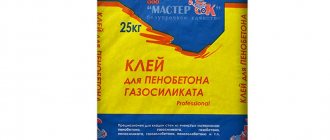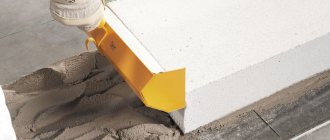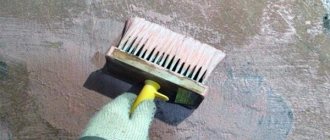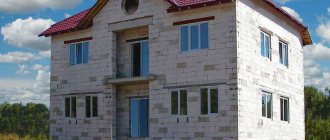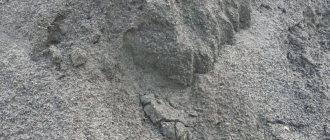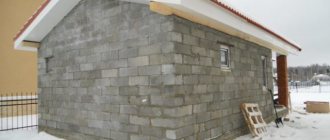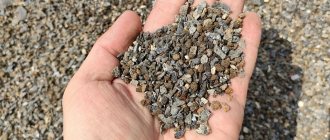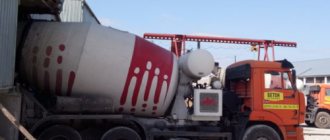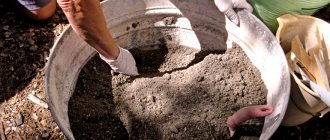Glue for foam blocks is often used instead of mortar. It provides high adhesion of materials, which allows you to increase the service life of the finished structure. In addition, when applying such mixtures, a layer of thin thickness can be made; in this case, the adhesion strength is not reduced. The adhesive helps reduce the intensity of heat loss.
It is noted that the special glue dries much faster than the classic solution of sand and cement. These factors help speed up installation.
Block glue is used instead of mortar.
Review and description of adhesives for foam concrete blocks
Foam concrete blocks are a really warm and easy-to-work wall material. But only on the condition that the laying is done not with ordinary sand cement, but with glue. It is more viscous, sets faster, does not shrink, but most importantly, porous stones do not draw water out of it. Well, of course, gluing walls is simpler and easier than forming thick seams. Nevertheless, it is important to choose the right mixture, since the strength of the entire building depends on its quality.
- Description and types of adhesives
- Glue consumption per m3
- Review of popular products and prices
- Recommendations for use
Features of installation compositions
The adhesive mortar for foam concrete blocks, like regular masonry, contains Portland cement - but only the highest quality and most expensive, without substitute additives. In addition, purified fine sand with a grain size of no more than 2-3 mm is added here. And so that the mixture, even with a small thickness of the seam, reliably holds the foam blocks in the masonry, various additives and modifiers are added to it, giving it useful properties:
- Moisture resistance.
- Plastic.
- High adhesion to foam concrete.
- Water retention.
First of all, it is necessary to distinguish between compositions intended for certain operating conditions. And if in the warm season any mixture designed for an air temperature of +5 ° C is suitable, then in winter it is better to choose frost-resistant adhesive for cellular concrete. It is easily recognized by the snowflake icon on the packaging. But even such solutions are not recommended for use at -10 °C, although they contain special antifreeze.
Cement-based options are sold in the form of a dry powder - they must be mixed immediately before you start gluing the foam blocks. The second type is polymer mixtures in small cylinders for a mounting gun. Their choice is small, and adhesion is worse than that of cement ones. And although adhesive foams adhere quite reliably to the porous surface of cellular concrete, it is not recommended to use them for the construction of load-bearing walls.
When building walls from aerated concrete, study the overview of adhesive mixtures for aerated concrete.
Type of glue used
The amount of adhesive mass, regardless of the form of delivery (dry mixture, ready-made solution), is determined in kilograms.
First, choose the type of glue: there are several of them, and they differ in the basis.
Cement
For a number of reasons this type is the most popular:
- is cheap;
- easy to use;
- does not require leveling the base (the glue itself can act as a leveling mixture).
Supplied in the form of a dry mixture intended for mixing with water or, if increased moisture resistance is required, with liquid latex.
Depending on the thickness of the layer, the need for it is 1.9 – 7.6 kg/sq.m. m (data for Ceresit glue).
Dispersive
An expensive type of glue, especially strong and solvent-free. Created for:
- external tile material, which due to its pronounced relief has significant weight;
- facing problematic bases: metal, glass, wood, plasterboard, plastic and others with a smooth surface.
Delivery form: ready-made solution. Consumption is 2 times lower than that of cement glue.
Epoxy
Another expensive special purpose glue.
Has the following advantages:
- significant strength: in this respect it is not inferior to ceramic tiles;
- high adhesion: used for gluing smooth surfaces;
- absolute moisture resistance: used for cladding structures that are exposed to direct water for a long time or constantly;
- transparency: does not change the color of porous tiles and is suitable for gluing glass;
- ability to maintain performance at low temperatures;
- no shrinkage.
The adhesive composition is prepared immediately before use from two components - the base material and the catalyst. Depending on the thickness of the layer, consumption ranges from 2.4 to 6.4 kg/m2.
Polyurethane
Distinctive features of this composition:
- chemical resistance;
- moisture resistance;
- plastic;
- wide range of operating temperatures: from -550С to +1250С.
Polyurethane compositions are used for cladding “warm floors” and structures subject to deformation or vibration.
Available ready-made or two-component (preparation required). With the smallest layer thickness (light tiles) the consumption is 2.5 kg/m2, with a larger layer (heavy tiles) - 3.5 kg/m2.
Consumption per cubic meter
It is only at first glance that the cost of glue for laying foam blocks seems more than the price of a regular mortar. In fact, modern compounds, due to their strong adhesion, are applied in a much smaller layer. An experienced masonry worker can make seams only 1-3 mm wide, while sand cement will require 10-15. This difference also results in savings in costs. Of course, you shouldn’t expect serious savings, especially if this is your first time gluing foam blocks, but you won’t have to overpay.
To calculate the quantity, it is customary to start from the manufacturer’s recommended seam thickness of 3 mm. In this case, for foam concrete masonry, the consumption per m3 of glue will be approximately 20 kg. In practice, inexperienced builders cannot spread the finished mortar so thinly the first time, and the seams end up being 5 mm wide. The same thing happens when the quality of the foam blocks is not high enough with minor defects and surface irregularities. Accordingly, the consumption of the adhesive mixture can increase to 30 kg/m3. To convert the resulting figure to square meters, simply divide it by the thickness of the wall.
You can save money if you choose foam concrete blocks with profiled edges that fit into a tongue-and-groove lock. Here you only need to glue the horizontal edges, the vertical seams are not coated. You can also reduce consumption by 25-30% by applying the solution with a notched trowel. But in any case, it is worth purchasing one spare bag of glue.
Review of popular brands
To make foam concrete walls truly strong and reliable, builders recommend choosing a good masonry adhesive from a well-known manufacturer, regardless of the cost. Let's list the mixtures that have already earned positive reviews.
1. Ceresit CT 21.
A cement composition with high adhesion to foam concrete (0.8 MPa) and frost resistance down to -30 ° C, although it is not intended for winter application. Its main characteristics:
- Consumption for each 1 mm of seam is 1.3 kg/m2.
- The viability of the solution does not exceed 2 hours.
- The time to adjust the masonry after application is 20 minutes.
2. Volma block.
An inexpensive option with fairly large aggregate grains. On the one hand, this is not very good, since it increases the thickness of the seam and, accordingly, glue consumption. On the other hand, it allows not only to reliably fasten masonry, but also to use it as plaster for foam concrete, filling small defects when leveling walls. However, this mixture leaves the least amount of time to correct flaws - only 10 minutes with a total glue pot life of 2.5 hours. Consumption - 1.4 kg/m2 per 1 mm of seam.
3. Founds Selform T112.
Winter composition in gray or white can be purchased in 20 kg bags. Consumption – 1.4 kg/m2, open operation time – 15 minutes. The prepared solution sets within an hour or two, which is very good. Osnovit also differs from others in its frost resistance - the formed seams can withstand up to 75 thawing cycles.
4. Ytong winter.
The frost-resistant adhesive mixture for foam blocks with salt additives is distinguished by a very fine filler fraction, which allows you to create really thin joints from 1 mm. As a result, the total consumption is noticeably reduced - to 1.6 kg/m2.
5. Bonolit Tytan.
Polyurethane adhesive foam is available in a convenient tube for a mounting gun. But Titan is demanding on the quality of stones - they must be virtually flawless. And the composition itself is afraid of sunlight, so after finishing the work it is better to immediately do the jointing or plaster the walls outside. But with one cylinder, with sufficient experience, it is possible to glue up to 1-1.5 m3 of blocks at a time.
Price
| Glue brand | Seam thickness, mm | Packaging, kg | Price, rubles |
| Ceresit CT21 | 2 | 25 | 290 |
| Volma block | 2-5 | 25 | 188 |
| Founds Selform T112 | 2-5 | 20 | 183-216 |
| Ytong (winter) | 1-3 | 25 | 326 |
| Bonolit Tytan | 2 | 0,75 | 300 |
Adviсe
Manufacturers always provide a description of the preparation of the mounting solution on the packaging. But it’s better to know the general principle:
1. Dry glue is poured into a clean container and filled with warm water - as a rule, 5-6 liters are enough for a bag.
2. Mix well with a construction mixer or drill with an attachment at low speed.
3. Let the mixture stand for 5 minutes so that the glue for the foam blocks “ripens”, and mix again.
A properly prepared solution, after applying it to the block with a notched trowel, should hold its shape and not spread. In this case, it is advisable to cook in small portions - the viability does not exceed 2-2.5 hours, and it is consumed very slowly. The composition that has begun to set in the bucket can be mixed once or twice more, but then you will have to prepare a fresh portion - it will be useless to glue anything with it.
Frost-resistant mixtures have their own nuances in preparation. They need to be sealed with water heated to +50..+60 °C and make sure that the glue temperature does not fall below +10 °C. At the same time, the foam concrete blocks themselves should not be frozen or icy. You will have to work faster, since the viability of such solutions is much less - they remain mobile for no longer than 30-60 minutes.
From the author: We welcome you, dear reader. Our article is devoted to a particularly relevant topic in the construction of both private residential buildings and other non-residential buildings (for example, garages or greenhouses). We will find out what glue consumption for foam blocks is per 1 m3. In addition, we will analyze what the specifics of work depend on when constructing masonry from this material, find out what its pros and cons are, and also answer the question why it is worth using glue, and not the masonry mortar that is already familiar to us .
But first, the most important thing. We will learn how to calculate the amount of glue for foam blocks per 1 cubic meter. Let's get started.
Consumption rates for different solutions
Depending on what concrete is needed for, 1 m3 of solution may contain different volumes of cement. In modern construction, concrete mortar is used to carry out four tasks: pouring the foundation, laying building blocks, pouring screed and performing plaster. For each of these types of work, it is assumed that a certain type of mortar with a specified volume of cement will be prepared.
The highest consumption of cement per cube of mortar is obtained when preparing a mixture for masonry or plaster. When pouring a foundation or screed, it is important to use large fillers (gravel, crushed stone, slag), which reduces cement consumption. The purpose of the solution is indicated by the brand (the properties of concrete and the main characteristics depend on it).
concrete according to GOST:
- M100 – 170 kilograms of cement
- M150 – 200 kilograms
- M200 – 240 kilograms
- M250 – 300 kilograms
- M300 – 350 kilograms
- M400 – 400 kilograms
- M500 – 450 kilograms
For plaster
A standard plaster solution is prepared from 3 parts sand and 1 part cement. If the layer is made with a thickness of no more than 12 millimeters, then 1.6 kilograms of M400 cement and 1.4 kilograms of M500 cement are weighed per 1 square meter of plaster. The volume of mortar per cubic meter of masonry can be calculated as follows: 1 m2 x 0.012 m = 0.012 m2 = 12 liters.
On masonry
For a square meter of brickwork one brick thick, you will need at least 75 liters of M100 mortar. is 1:4. Thus, it amounts to 250 kilograms per cubic meter of sand. How many cubic meters of solution will be needed in total is calculated based on the size of the building.
Water is taken in half the volume. So, if you mix the solution using buckets, it turns out like this: 1 bucket of M500 cement, 4 buckets of sand, 7 liters of water.
For the foundation
To prepare a solution for pouring the foundation, you need to calculate everything correctly. Typically, a solution of grade M100-M300 is used. The strength of M100 is sufficient for low-rise buildings, M150 and M200 are suitable for buildings of several floors. The higher the grade, the stronger the structure will be. For mixing, take cement M300/M400 (1 part binder and 3 parts sand) or M500 (1 part binder and 5 sand).
Cement consumption per cubic meter of solution:
- M50 (based on M400 cement) – 380 kilograms
- M100 (based on M300 cement) – 214 kilograms
- M200 (based on M400 cement) – 286 kilograms
- M300 (based on M500 cement) – 382 kilograms
Such calculations are relevant if the mixture is prepared according to the following proportions: 1 part cement, 2-4 parts sand, 3 parts crushed stone/gravel.
For screed
The proportion for mixing is as follows: 1 part cement and 3 parts sand. Here you can give an example of correct calculations. So, you need to fill a surface of 3 by 4 square meters (12 is obtained) with a layer thickness of 30 millimeters.
Calculation steps:
- Determining the required volume of concrete solution: 12 m2 x 0.03 m = 0.36 m3.
- Choosing a brand of concrete - take M200, prepare it from M500 cement, which requires 410 kilograms.
- Calculation of the number of bags of cement: 410 kg x 0.36 m3 = 148 kg / 50 = 3 bags (almost).
- How much sand is needed: 1600 kg/m3 (weight of a cubic meter of mixture) x 0.36 m3 (required amount of mixture) = 576 x 0.75 (proportion of sand in concrete) = 432 kilograms. A cube of sand solution will take about 1200 kilograms.
Glue consumption for foam blocks per 1m2/m3
The glue consumption rate per 1 m2 is approximately 1.5–1.6 kg of dry powder with an applied thickness of 1 mm, therefore, 15–30 kg will be consumed per 1 m³. As we can see, the numbers are approximate, since it is almost impossible to give an exact figure for how much glue is needed per foam block cube. But we will allow ourselves to average the indicators - and name a certain weight - 25 kg. This is exactly the weight of one bag of adhesive composition. Knowing this, it will be easy for moms to calculate how much glue is needed to build the masonry. And for greater convenience, we present to your attention the list below:
- per 1 m² - ≈1.5 kg;
- per 1 m³ - ≈25 kg (one bag).
This is the glue consumption for foam blocks 20x30x60/40x30x60 - the average is 25 kg. But in practice, things can happen completely differently. It also happens that ≈1.5 bags are consumed per 1 m³. The fact is that this is influenced by certain factors, which we will now list in the form of a list:
- use of the tool. Here improvisation will be inappropriate - the tools we need to use are those that are intended for our purposes;
- condition of masonry materials. Their surface should be even and smooth, but it happens that their condition cannot be called ideal;
- weather. During the cold season, it is better to refrain from such work, especially if you are not a professional in this matter;
- master's qualification. This point follows from the previous one. Naturally, to perform such work properly, certain knowledge and experience in this field is required.
The method of applying and preparing the adhesive composition also affects its consumption. Therefore, when preparing, you need to use only a drill mixer (kneading by hand is a thankless task), and dilute with water until a homogeneous consistency. The composition should not be very dry and thick, but also not too thin and liquid, since - in both cases - it will not perform the functions assigned to it.
I have heard the opinion that the composition can be diluted with sand in proportions of almost 1:1. Allegedly, this will increase strength and, most importantly, it’s cheaper, because less dry powder will be used.
So, this opinion is wrong. Mixing sand (or anything else) is not allowed. Otherwise, the composition will be heterogeneous, the layer will be uneven and, as a result, the wall will be uneven. And this should not be allowed, even if you are pursuing such noble goals as saving or increasing strength. In addition, there will be no savings here. To even out the layer, you will have to make it thicker, because, as they say, that’s what it will do.
The composition should be applied to the surface of the block in an even, thin layer. The thickness is usually up to 3 mm. Naturally, no one specifically measures this indicator unless it is laboratory research. In this matter, as in any other, you need skill, which comes with practice. But this matter cannot be called overly complicated. Having laid 5-10 elements of the future structure, you will already be laying them as if you have been doing this all your life.
Keep in mind that no matter how accurate your calculations may seem to you, the material must be purchased with a small margin. This applies not only to the glue, but also to the masonry elements themselves. If you have small leftovers, this is not critical. In any case, they may be needed another time, but if suddenly something is missing, it is much worse, especially if you need to complete construction in a limited time.
So we figured out how much glue is needed for one cube of foam block. We can draw an analogy with both aerated concrete and gas silicate. After all, all the listed building materials belong to the same group and they are laid according to the same principle.
We have already found out the most important thing. Now let's talk about the advantages of using an adhesive composition when laying gas blocks or foam blocks.
Adhesive for aerated concrete - what is it?
Glue for aerated concrete blocks is a dry construction mixture based on binder and fine aggregate. Produced in accordance with GOST 31357-2007. Sold and supplied in dry form, for use it is diluted with water in accordance with the manufacturer's instructions. Testing of materials in a dry state, in the form of a liquid mortar and cement stone is carried out in accordance with GOST 31356-2007. Adhesive for aerated concrete blocks is not included in the list of building materials that require mandatory SGR certification. Manufacturers of dry mixtures undergo it voluntarily, which is a definite plus and indicates the high quality of their products.
What are the advantages of glue?
The adhesive composition was not developed by chance. Its use in work has a number of significant advantages over the same conventional masonry mixture that is used when constructing a wall of bricks. Actually, here are the advantages:
- the presence of Portland cement in the adhesive composition, as well as fractional sand. This allows you to reduce the thickness of the applied layer;
- Thanks to its structure, the glue is evenly applied to the work surface, filling the space. Due to this, the adhesive properties increase;
- One bag of dry mixture (25 kg) will take about 5.5 liters of water. Due to this, the humidity level inside the building will be within normal limits (if the construction took place in the warm season in warm weather);
- low ability to transmit heat. Thanks to this property, the likelihood of cold spots forming is reduced;
- high ability for adhesion (adhesion to the working surface);
- resistance to cold and humidity;
- quick setting and drying of the adhesive composition without (!) any shrinkage;
- economy. The fact is that glue can be used not only for its intended purpose - that is, for gluing, but also as putty;
- relatively low cost;
- ease of use (of course, if you have certain professional skills).
The mixture must contain the following components:
- Portland cement;
- fine-grained sand that has undergone sieving;
- modifiers;
- polymer additives.
By the way, the type of adhesive that you use in your work depends on weather conditions. Everything here is quite simple: in the cold season you should use a frost-resistant composition. Naturally, it should be prepared not in the cold, but at room temperature - ≈20°C, and diluted with hot water - ≈50°C. The time for thickening and setting of the prepared mixture in the cold is very short (much less than in the summer heat), which is why you need to work quickly. You will have approximately 2–3 minutes to adjust one laid element. But if you have not encountered such work before, it is better to wait for warmer weather (or turn to professionals who will do all the work for you). But in the summer you can safely start building masonry with your own hands.
And in order to significantly reduce glue consumption and complete the job at the proper level, you will need the “proper” tools for the job. Here is their list:
- notched spatula for applying adhesive composition;
- rubber hammer;
- mixing blade;
- saw with carbide teeth;
- wall chaser;
- coarse grater;
- metal brush;
- 90°C square to cut at right angles.
We have successfully figured out the advantages of the adhesive mixture. Now let's talk about the foam blocks themselves, that is, let's find out what their strengths and weaknesses are and how to work with them correctly.
Specifics of work in winter
Work on the construction of walls in most cases does not stop with the end of the warm period. Adhesive compositions for foam blocks allow masonry to be carried out even in winter due to special silicate and polymer additives.
Even when using glue with frost-resistant components, certain rules should be followed. The solution must be kept warm during operation, and its temperature should not fall below zero degrees. The entire prepared glue solution is used within 30 minutes, and it is better to insulate the container in which it is located.
What are the advantages of aerated concrete?
The material we are considering is quite popular in the countries of the former USSR, and not only. It is used to construct both residential private houses, as well as garages and greenhouses, that is, buildings for household needs.
What is the reason for such popularity? But now we’ll find out. Below is a list of the advantages of this building material:
- good thermal insulation properties. This does not mean that the house will not have to be insulated at all, but the structure of the material looks like the blocks themselves are a good insulation material;
- relatively high operating speed. The blocks are much larger than standard bricks, so it takes less time to construct the masonry;
- saving of fastening solution. Compared with brickwork, masonry made of aerated silicate/aerated concrete/foam concrete will require less fastening material. If we try to reduce all the indicators to a common denominator, we will end up with the following result: you will spend 20–25% less than the treasured ₽ (or ₴) on a fastening solution for a gas silicate wall;
- relatively low cost. A wall made of gas silicate will cost you less than a wall made of bricks of the same height.
Of the shortcomings, we can highlight two main ones. In this respect, foam concrete is inferior to the same bricks:
- Firstly, it has a high ability to absorb moisture. And if the building material absorbs moisture well, then this is fraught with dampness, the formation of fungal colonies on the walls and ceiling, and so on. To avoid these negative consequences, it is necessary to properly finish the building;
- secondly, less strength compared to brick. This directly affects the durability of the structure, although it all depends on how well the work was done. It goes without saying that if the quality of the bricklaying is poor, then such a structure will not stand for a relatively long time.
This list can be supplemented with one more item that is worth considering. This is an unattractive appearance, and, as a result, there is a need to decorate the outside walls of the house. If brick cladding is often left in plain sight, as with foam-gas blocks, this will not be the best solution from a purely aesthetic point of view.
Now you have an idea of the strengths and weaknesses of the building material in question. We will now briefly describe the construction process to give you an idea of what kind of construction work lies ahead.
Use of reinforcing mesh.
The use of a mesh for laying gas silicate blocks on glue is necessary to increase the strength of the structure. Reinforcing mesh is divided into three types according to the type of materials from which they are made: metal, basalt and fiberglass. Metal and basalt reinforced meshes are most often used to strengthen the load-bearing structures of a building. Fiberglass meshes are used for non-load-bearing structures (partitions), as they have less strength compared to iron and basalt meshes.
DIY construction
It is logical that you should start by laying the first row of blocks. Only they need to be laid not using glue, but using ordinary masonry mortar. The minimum thickness of the applied layer of cement-sand mixture should not (!) be less than 10 mm. The mixture does not dry as quickly as glue, so you will have plenty of time to adjust the position of the block.
First you need to find the highest angle, since the construction of any walls should always start from this place. Next, using fishing line, we outline the wall. Anyone who has dealt with the construction of a house understands what we are talking about. Anyone who has not encountered this will not learn how to build walls without practice.
Now lay the foam blocks. You need to lay one block at each corner, and then stretch the rope between them. Only after this can you begin laying the remaining elements. When laying, be sure to use a building level to control evenness. This is how the elements are laid around the perimeter of the future building. But, naturally, where it is supposed to make an entrance/exit to the building, foam blocks should not be laid.
To level the horizontal plane of the row, use a float and a level. There is nowhere here without him. Below is a video that clearly demonstrates this process:
All subsequent rows must be laid using glue. Laying should begin from the corners, only with bandaging, i.e. — with a shift of half a block. If you can’t move it halfway, keep in mind that the shift must be at least 80 mm.
Window openings, as a rule, have a height of 4–5 rows of gas-foam block masonry from the foundation. It is necessary to perform reinforcement under this opening, and the reinforcement should begin from the third or fourth row - it depends on which of the rows the window will be located from - from the fourth or from the fifth.
To properly perform reinforcement, you need to make two parallel furrows using a wall chaser. Although you can also use a grinder for these purposes. On each side, these grooves must extend beyond the width of the future window by at least 300 mm. Now, as you may have guessed, reinforcement is placed in these grooves and then fixed using cement-sand mortar. Next, we continue to build the wall in the same way as before the reinforcement procedure.
It is necessary to install special lintels over door and window openings using a reinforcing belt. This must be done to increase the reliability of the building. For these purposes, we will need gas blocks/foam blocks shaped like the Latin letter “U”.
Then continue the laying as before, after which, when the first floor is completed, perform reinforcement and pouring.
Main characteristics
The technical characteristics of a specific adhesive composition for aerated concrete blocks depend on its composition and proportion of components. The composition of glue of different brands differs slightly:
- high-quality cement (GOST 31108-2016);
- washed fine sand (GOST 8736-2014);
- polymer and mineral additives (GOST 24211-2003).
Water is used to dilute dry mixtures (GOST 23732-2011). In order for the solution to have all the declared technical and operational properties, it must be prepared strictly according to the manufacturer’s instructions.
The main qualities by which aerated concrete adhesive is evaluated:
| Dry | In liquid state | In a hardened state |
| humidity | mobility | compressive strength |
| grain | preservation of mobility | water absorption |
| coarse grain content | water holding capacity | frost resistance |
| bulk density | volume of entrained air | adhesion to surface |
Types and composition
The composition of the dry mixtures from which glue for foam blocks is prepared includes several components.
- Portland cement is a hydraulic binder that provides strength to masonry. Thanks to it, the solution quickly “sets”.
- Modifiers prevent moisture from penetrating, which ensures the integrity of the seams.
- Quartz sand (fine fraction) - allows you to create seams from 2 to 5 mm.
- Polymer additives – increases the level of adhesion and plasticity, ensures the filling of all cavities with the adhesive mass.
There are 2 main types of adhesive mixtures:
- Winter - gray, designed for operation in temperatures from plus 5 to minus 15 degrees. The composition contains special anti-frost components that allow the glue temperature to remain positive; the dry mixture is diluted with water heated to +60 degrees. The solution must be used within half an hour.
- Summer - it contains white cement. Suitable for operation in modes from +5 to +30 degrees, use for two hours.
Advice:
Follow the instructions strictly! Inaccurate adherence to proportions will lead either to rapid hardening of the composition or to a violation of plasticity. This will entail a deterioration in the quality of the adhesive solution.
Popular adhesive mixtures
When deciding which adhesive to choose for gas silicate blocks, it is worth studying the features of current offers.
Aerostone is a product of the Dmitrovsky Aerated Concrete Products Plant. Cement-based mixture with polymer additives. The product is presented in winter and summer versions.
Aerostone adhesive for gas silicate blocks
- Thermocube is an adhesive mixture for interior and exterior work, intended for thin-seam masonry of walls and partitions based on grooved and grooveless gas silicate blocks. The building material is distinguished by high qualities of strength, frost resistance and ductility. Provides economical consumption.
- Ilmax2200 – adhesive for laying blocks of porous concrete, including gas silicate, foam concrete, expanded clay concrete slabs and other wall panels. Frost resistance of the product is 75 cycles, operating temperatures range from -30°C to +70°C, temperatures for block laying work range from +5°C to +25°C. The prepared solution is used within 4 hours.
- Ceresit is perhaps one of the most popular construction brands, a supplier of high-quality mixtures for various categories of work. Ceresit CT21 adhesive is made on the basis of cement; mineral fillers and organic modifiers are included as additives. The product is used for thin-layer masonry of gas silicate wall blocks and other types of cellular concrete panels.
- Knauf - a gypsum-based adhesive composition provides strong adhesion to the surface. The products of this manufacturer are in demand due to their competitive quality, although they are sold in the expensive segment. Knauf Perlfix adhesive mixtures with an environmentally friendly composition are easy to apply and allow you to quickly level the blocks.
- IVSILBlock - the mixture is used for laying grooved and conventional blocks made of porous concrete. Polymer inclusions increase adhesion, and modifying additives impart plasticity to the binder base. The position of the blocks when laying with this solution can be adjusted within 25 minutes, which is considered a competitive advantage of the material.
- Aeroc is a product of a company producing cellular concrete from St. Petersburg and occupies a leading position in the domestic market of construction resources.
- "Zabudova" is one of the best adhesives for gas silicate blocks. The products are valued for their high performance when used in winter at a relatively low cost. The composition performs well at ambient temperatures down to -15°C, is easy to mix and apply, consumption is more than economical, seams are not subject to atmospheric influences.
- Unic Uniblock is a brand that produces high-quality gas silicate blocks and masonry mixtures; the products are sold in the middle segment.
- Bonolit - a dry concentrate for gluing gas silicate deserves attention due to its absolutely environmentally friendly composition, has no toxic impurities, and is in demand for both external and internal work.
Adhesive for gas silicate blocks Bonolit
- “Prestige” - the mixture is used for laying all types of porous concrete blocks; it is characterized by high frost resistance due to its composition with modifiers.
- “Pobedit” is a multicomponent cement-based adhesive with quartz sand and polymers; its composition is completely identical to aerated concrete blocks and is capable of adhering to the surface with the highest quality, forming a monolithic composition.
- "EK Chemical" - the mixture is intended for thick-layer masonry, suitable for work in any season. In addition to constructing walls and partitions from blocks based on cellular concrete, the composition can be used when installing ceramic tiles and leveling wall surfaces.
Why do you need to choose adhesive for foam blocks rather than cement mortar?
Despite the fact that the adhesive composition is 3 times more expensive than cement mortar, the savings in its use have been proven in practice. The thing is that for good adhesion it is enough to apply a layer of two millimeters, which means that you will use several times less glue for foam blocks when compared with a regular cement mortar.
Advice:
The consumption of adhesive per 1 m2 (1 m3) depends on how high-quality your blocks are. If they have an ideal geometric shape, then the need for adhesive per 1 m2 (1 m3) for foam blocks will be minimal.
- Using the adhesive mixture option for winter conditions, the house can be laid even in frosts down to minus 15 degrees.
- There is no excess moisture in glue joints, which means that the appearance of mold or mildew is almost impossible.
- The use of an adhesive solution significantly increases the energy efficiency of the house, which allows you to save up to 35 percent on heating.
- Assembly adhesive for foam blocks is quite plastic and does not harden instantly, which is important when adjusting the masonry; the main thing is to use the prepared adhesive for a certain time: then it will not lose its properties.
Preparation of the solution
Types of mixtures for laying expanded clay concrete blocks:
- Ready-made powder solutions;
- DIY prepared mixtures.
Two types of solution are popular among consumers. The main thing is the correct selection of the manufacturer’s brand or ingredients in order to prepare the composition.
To prepare the concrete mixture yourself, it is recommended to use a concrete mixer; this unit will allow you to thoroughly mix all the components. The quantity and quality of cement mortar affects its strength. In addition to cement, lime is used as a binding component, but such an element can collapse under unfavorable environmental conditions. Lime has the properties to increase the thermal insulation qualities of the solution; for this you will need to take one part of lime and one part of dry cement, add 4 parts of sand. It is better to use purified fine sand. This method is the simplest and most popular.
The mortar for laying expanded clay concrete blocks differs in density:
- If you need to prepare a mixture of 25 strength, then the ratio of sand and cement will be 5:1.
- For the M 50 mixture, the components are selected 4:1.
- For higher strength M 75 the ratio will be 3:1.
It is recommended to add cold and pre-purified water for making solutions. Its consumption will depend on the required volumes and the container intended for mixing the solution. Approximately 25% of it should be part of the total volume of the mass.
Adviсe
- the solutions are prepared before they are used;
- there is no need to prepare the workpiece long before starting work, since the solution has the properties of rapid hardening - literally in 1.5-2 hours. The necessary qualities will be lost.
Work progress
- A small amount of water is poured into the expanded clay concrete mixer.
- Then the required amount of sand and concrete is poured.
- Everything is thoroughly mixed, this method does not allow the formation of lumps.
- After mixing is completed, add the remaining water to the mixture.
On average, the consumption of solutions per 1 cubic meter of masonry blocks made of expanded clay concrete will be 40 kg.
How to choose the right glue
When constructing a structure made of foam blocks, many developers cannot decide which adhesive solution to choose. Each construction material has a lot of technical parameters that need to be sorted out: which adhesive property for foam blocks is best to give preference to. An important factor when choosing an adhesive mixture is its cost. But, do not forget that cheap is not quality.
Mixtures of the brands YTONG, Quick-Mix, AEROC, Bonolit, Ceresit have proven themselves well on the Russian market. They are usually packaged in standard containers of 20-30 kg. When choosing adhesive for foam blocks, you need to take into account an important economic argument - the consumption of the adhesive substance. Agree, the thicker the seam, the higher the costs. If the thickness of the seam in your masonry is no more than three millimeters, then on average up to 5 kilograms of glue are consumed per 1 m2, and up to 20 per 1 m3. This data will allow you to accurately determine the consumption of glue for foam blocks and how much this glue costs.
Choosing adhesive for foam concrete
The best option for purchasing a good adhesive composition is to perform practical tests. You need to purchase several brands and glue a couple of blocks together with the finished composition. After a day, you need to break the connection and inspect the fracture site. If parts are broken at the seam, you should not use such glue in the future. A connection where a partial fracture of the seam has occurred with deformation of the foam concrete itself can also be considered bad. Only the block should be damaged, and the adhesive seam should remain intact, in which case the composition is trustworthy.
Another test is carried out like this: dilute 1 kg of each dry mixture and fill identical jars. After a day, weigh the containers. Where the weight is least, the highest quality glue is located. Moisture leaves quickly, therefore, thermal conductivity will be high
When it is not possible to test adhesives, when choosing, you should pay attention to the reputation of the manufacturer, frost resistance (if this is important), fraction size (it should be small)
How to properly prepare glue for foam blocks
The first and strict rule is to strictly follow the instructions and our advice. Glue for installing foam blocks is diluted with water, like any solution. The mixture itself is ready for use; there is no need to add anything else to it.
Initial mixtures are supplied by manufacturers ready for use; you just need to mix them with water.
- As soon as the mixture reaches the desired viscosity, you can begin work.
- The adhesive composition is diluted in a regular bucket - this is the most convenient container.
- The absence of lumps in the adhesive solution leads to more economical consumption of the composition. It is better to stir the mixtures with an electric drill with a special attachment or a mixer.
- Practical skills in block laying will allow you to correctly calculate how much finished glue you are guaranteed to use in 2 hours.
- Stir the adhesive solution from time to time and it will be at the correct consistency. It is not recommended to dilute the thickened solution - this will lead to a deterioration in its quality and make it unsuitable for use.
Materials and tools for installation
To lay a wall from a gas silicate block, traditional materials and tools are prepared. It is worth considering specific tools in more detail :
- trowel;
- rubber mallet;
- wide spatula;
- notched spatula;
- special carriage.
Using a trowel, the master applies the solution to the spatula. A rubber mallet is necessary for correcting a block in masonry, as it will not destroy the structure of the stone. The composition is applied with a wide spatula, and with a serrated spatula it is distributed into strips. A special carriage is used to level the adhesive layer between the blocks.
How to work with glue
The process of laying foam blocks involves several stages:
- First, preparing the material for work: before work, you need to clean the foam block, otherwise dirt or dust can worsen the adhesion process, which will greatly weaken the reliability of the bond. Secondly, the first row of foam blocks and the foundation must be placed on a cement mortar to strengthen the frame. For the next rows, an adhesive mixture is used.
- Prepare glue according to instructions exactly.
- To strengthen the adhesion, you can use a primer.
- Apply the adhesive in an even layer using a notched trowel. Use a building level for control.
- The applied layer should be at least two millimeters - this will ensure optimal fixation.
- An adhesive substance is applied to the foam blocks, then they are pressed quite tightly against one another, ensuring that there are no cracks.
- Upon completion of the work, the masonry should stand for several days for the house to shrink. The hardening time of the adhesive mixture often depends on climatic conditions; a day is enough for complete hardening.
Adhesive for foam blocks provides excellent opportunities to reduce the time required to lay a house. Provides excellent adhesion of the material to the base, is easy to apply and spread over the surface and dries quickly enough. All these properties ensure high quality masonry. The thickness of the adhesive seam is very small - 2-5 mm, so it is quite easy to create smooth walls with regular geometric shapes. But if you do not have any experience in laying walls, it is better to invite professional builders.
Popular posts
- Chair for dressing table Chairs for dressing tables in Moscow - 189 Products Company from Moscow, delivery 29643 a In…
- Silicone sanitary sealant Silicone sanitary sealant white in Moscow - 1491 products Company from Moscow, delivery (tomorrow) 140...
- Shelf in the hallway Currently, there are a huge number of different options for shelves in the hallway, and this is directly ...
- Insulation of the floor in a wooden Insulation of the floor in a wooden house from below: materials and installation technology SHARE ON SOCIAL NETWORKS One of the common…
Step-by-step instruction
To comply with all masonry rules, follow the instructions:
- Prepare the surface: clean the blocks from dust and dirt.
- Mix the solution to the desired thickness in the required quantity.
- Apply the mixture to the blocks on 2 sides: main and end.
- Place on the masonry and level.
- Excess glue is wiped off with a rag.
For external walls, a joint thickness of no more than 5 mm is used. External walls need to be reinforced to strengthen them, since the building material itself is not strong enough. Internal walls must be connected to load-bearing walls using flexible ties or anchors.
Experts recommend
Practitioners who use adhesive mixtures have gained some experience. Some advice from professionals.
To ensure reliable adhesion of the masonry, the foam blocks are moistened before forming the adhesive layer. The mixture goes on smoother.
Deformed blocks in places of damage are leveled. A plane can be used for these purposes. The resulting “powder” is blown off.
It is necessary to completely fill the side seams without leaving any voids. The blocks are fitted as tightly as possible.
Glue is used from the second row and above. The recommended height is 30-40 cm above the foundation. The beginning of the wall is done using traditional mortar.

